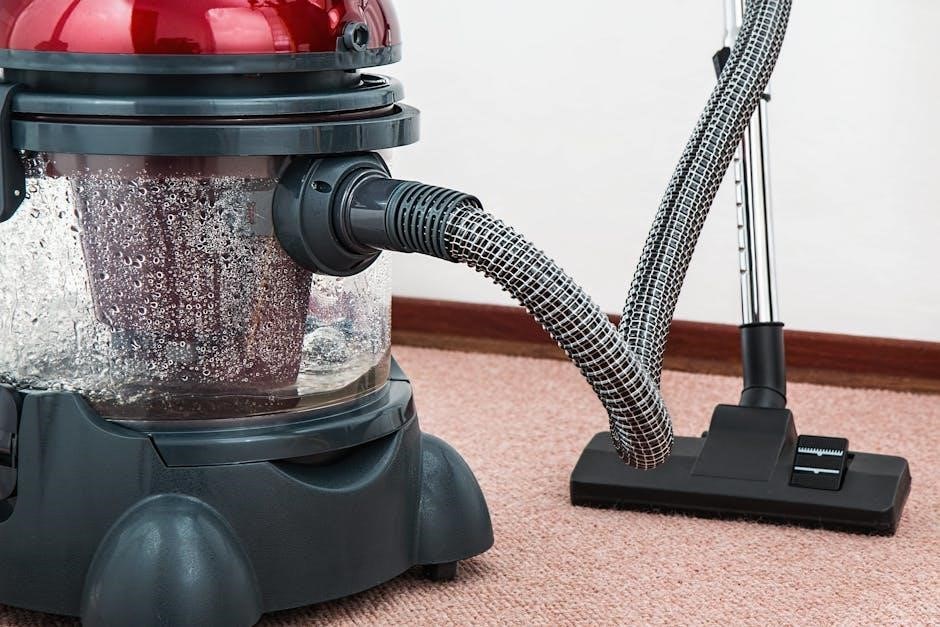
intex pool vacuum instructions
Learn how to efficiently clean your pool with Intex vacuum models like ZX100 and ZX300․ Follow these step-by-step guides for setup, operation, and maintenance to ensure optimal performance and safety․
1․1 Overview of Intex Pool Vacuum Models
Intex offers a range of pool vacuum models, including manual and automatic cleaners․ The ZX100 and ZX300 are popular automatic models designed for efficiency, while handheld vacuums like the CL1704 provide portable cleaning solutions․ These models vary in features, with some requiring connection to a filter pump with specific flow rates․ Automatic cleaners like the ZX300 are ideal for larger pools, while manual vacuums are lightweight and easy to use for smaller pools․ Each model is designed to ensure effective cleaning, making pool maintenance simple and stress-free for users․
1․2 Importance of Proper Pool Maintenance
Regular pool maintenance is crucial for ensuring a safe and enjoyable swimming environment․ Proper cleaning prevents debris buildup and maintains clear water, reducing the risk of contamination․ Intex pool vacuums, such as the ZX100 and ZX300, simplify this process by efficiently removing dirt and debris․ Regular use of these vacuums helps maintain balanced water chemistry and prevents damage to pool equipment․ By following Intex’s guidelines, you can extend the lifespan of your pool and keep it hygienic for years to come․
Setting Up Your Intex Pool Vacuum
Start by unboxing and inventorying all components․ Connect the hose to the vacuum head and prepare the pump and filter system for operation․
2․1 Unboxing and Inventory of Components
Start by carefully unboxing your Intex pool vacuum and inspecting the package for any damage․ Make a detailed inventory of all components, including the vacuum head, hoses, connectors, and any additional accessories․ Ensure all parts are included and free from defects․ Refer to the user manual for a comprehensive list of components․ Organize the parts in a clean, dry area to avoid losing any small items․ This step ensures you have everything needed for proper setup and operation․

2․2 Connecting the Hose and Vacuum Head

Attach the vacuum head to the end of the hose, ensuring a secure connection․ Next, connect the other end of the hose to the designated port on your pool pump․ Make sure the pump has a flow rate compatible with your Intex vacuum model (e․g․, 1600-3500 GPH)․ Tighten all connections firmly to prevent leaks․ Before turning on the pump, purge the hose of any air by submerging it in water․ This ensures proper suction․ Double-check all connections and follow the manufacturer’s guidelines for optimal performance․ Proper setup is key to effective pool cleaning․ Always refer to your user manual for specific instructions․
2․3 Preparing the Pump and Filter System
Before operating your Intex pool vacuum, ensure the pump and filter system are properly prepared․ Start by assembling the pump according to the manufacturer’s instructions․ Connect the pump to the pool and ensure it is compatible with your vacuum model․ Prime the pump by filling it with water to remove any air pockets․ Check the filter for cleanliness and replace or clean it if necessary․ Ensure the pump’s flow rate matches the vacuum’s requirements (e․g․, 1600-3500 GPH)․ Refer to your user manual for specific flow rate recommendations․ Proper pump and filter preparation ensures efficient suction and effective pool cleaning․ Regular maintenance will prevent clogs and keep your system running smoothly․

Operating the Intex Pool Vacuum
Turn on the pump, test suction, and begin vacuuming manually or automatically․ Ensure proper flow rate for optimal cleaning and adjust as needed for best results․
3․1 Turning On the Pump and Testing Suction
Before operating, ensure the pump is properly connected to the pool’s filtration system․ Turn on the pump and allow it to reach full pressure․ Check the suction by observing water flow through the vacuum hose; If suction is weak, inspect for blockages or air leaks in the hose connections․ For automatic models, verify that the cleaner moves independently․ Adjust the pump’s flow rate as needed to optimize cleaning performance․ Always follow the manufacturer’s guidelines for pump operation to ensure safe and effective pool cleaning․ Regular testing ensures efficient suction and prolongs equipment lifespan․
3․2 Manually Vacuuming the Pool Floor and Walls
Submerge the vacuum head slowly into the pool to avoid air bubbles․ Hold the handle firmly and move it across the pool floor in overlapping strokes․ Use the brush edge to scrub stubborn dirt․ For walls, tilt the vacuum head and glide it upward, ensuring thorough coverage․ Pay extra attention to corners and stairs where debris accumulates․ After vacuuming, turn off the pump and remove the vacuum head from the pool․ Regular manual cleaning prevents debris buildup and maintains water clarity․ Always store the vacuum head and hose properly after use to extend their lifespan;
3․4 Using Automatic Cleaning Features (for applicable models)
For models like the Intex ZX100 or ZX300, activate the automatic cleaning mode by connecting the cleaner to the pool inlet fitting․ The vacuum will operate hands-free, navigating the pool floor and walls on its own․ Ensure the pump flow rate matches the cleaner’s requirements (1600–3500 GPH)․ The cleaner automatically changes direction upon hitting pool walls, ensuring thorough coverage․ Regularly check for obstacles and ensure proper installation to maximize efficiency․ This feature saves time and effort, providing a hassle-free cleaning experience․ Always follow the manufacturer’s guidelines for optimal performance and longevity of the automatic cleaner․
Maintenance and Troubleshooting
Regularly clean the vacuum head and hose to ensure optimal suction․ Check for blockages and ensure the pump operates smoothly․ Address common issues promptly for efficient performance․
4․1 Cleaning the Vacuum Head and Hose
Regular cleaning of the vacuum head and hose is essential for maintaining suction power and overall performance․ Start by disconnecting the hose from the pump and vacuum head․ Rinse both components thoroughly with clean water to remove dirt and debris․ For stubborn blockages, soak the parts in warm water before scrubbing gently with a soft brush․ Ensure all openings are clear to restore proper airflow․ Allow the components to dry completely before reassembling and storing․ Regular cleaning prevents clogs and extends the lifespan of your Intex pool vacuum․
4․2 Replacing or Cleaning the Filter
Regular filter maintenance ensures optimal suction and pool cleanliness․ Start by turning off the pump and disconnecting the power cord․ Remove the filter from the pump housing and rinse it with clean water to eliminate dirt and debris․ For stubborn dirt, soak the filter in warm water before rinsing․ If the filter is damaged or excessively worn, replace it with a new one․ Reassemble the filter system securely and resume operation․ Cleaning or replacing the filter regularly prevents clogs, maintains proper water circulation, and prolongs the life of your Intex pool vacuum․
4․3 Common Issues and Solutions
Addressing common issues with your Intex pool vacuum ensures smooth operation․ Low suction? Check for blockages in the hose or vacuum head and ensure the filter is clean․ If the vacuum doesn’t move, verify proper pump flow rate and connection․ For automatic models, ensure sensors are clean and free of debris․ Leaks in the hose or connections can be sealed with replacement O-rings or gaskets․ Regular maintenance and troubleshooting help prevent these issues, keeping your pool clean and your vacuum functioning effectively․ Always refer to the user manual for specific solutions and guidance․

Safety Precautions and Best Practices
Always read the manual and follow instructions carefully․ Keep body parts away from openings and moving parts․ Use only specified accessories and ensure proper storage․ Disconnect power and sanitation devices before maintenance․ Regularly inspect equipment for damage․ Keep children away from the vacuum and pool area during cleaning․ Store the vacuum in a dry, cool place during winter to prevent damage․
5․1 General Safety Guidelines
Before using your Intex pool vacuum, always read the manual and follow all instructions carefully․ Ensure the area around the pool is clear of obstacles; Keep loose clothing and long hair tied back to avoid entanglement․ Never allow children to operate the vacuum unsupervised․ Avoid using the vacuum near open flames or sparks․ Always disconnect the power supply before performing maintenance or troubleshooting․ Regularly inspect the vacuum and its components for damage or wear․ Use only genuine Intex replacement parts to ensure safety and optimal performance․ Store the vacuum in a dry, cool place when not in use to prevent damage and extend its lifespan․
5․2 Storage and Winterization Tips
Proper storage and winterization are crucial to maintain your Intex pool vacuum’s performance and longevity; After the swimming season, disconnect the vacuum from the power source and disassemble it according to the manual․ Clean all components thoroughly with water, ensuring no debris remains․ Allow all parts to dry completely before storage to prevent mold or corrosion․ Store the vacuum in a cool, dry place, away from direct sunlight and extreme temperatures․ Use a protective cover or bag to shield it from dust․ Regularly check stored components for any signs of damage or wear․ Proper winterization ensures your vacuum is ready for the next season․